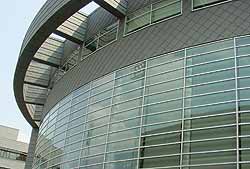Green Products: Trends & Innovations
Zinc Sustains Life
Zinc as a building material is relatively new to North America. It has been used for centuries in Europe. In fact, today 85 percent of all roofs in Paris utilize zinc.
Its durability, flexibility and malleability make zinc a great material to enhance the architectural pallette. Although relatively foreign to the U.S., it is being used today in a growing number of specialty projects in which designers are looking for striking effects.
|
The Guggenheim Museum in Bilbao, Spain, is partly clad in zinc. The renovated Herman Miller executive building, in Zeeland, Mich., a Gold-rated LEED project, and an AIA Top Ten Green Project for 2004, is clad in flatlock zinc panels.
Zinc is an environmentally friendly metal and has a unique allure that makes you want to reach out and touch it.
"Other products use a coating or paint to achieve what is natural to zinc−a rich, warm, gray color," says Norbert Schneider, president of U.S. operations for Belgian-based Umicore Group.
Zinc has a long history in building and is incredibly long-lasting. In all but coastal environments, zinc roofs may be expected to last for up to 100 years. It is this aspect of zinc that has led to the material's recent popularity with "green" builders.
It is an element essential for life and most organisms show a very high tolerance to zinc. Rainwater from zinc roofs can be used directly to water plants with no ill effects.
Its high metal content makes it practically 100 percent recyclable.










